On View
In Her First New York Survey, Virtuosic Painter Cecily Brown Makes Everything Old New Again
The artist's deep engagement with art history's favorite themes is on view at the Metropolitan Museum of Art from April 4.
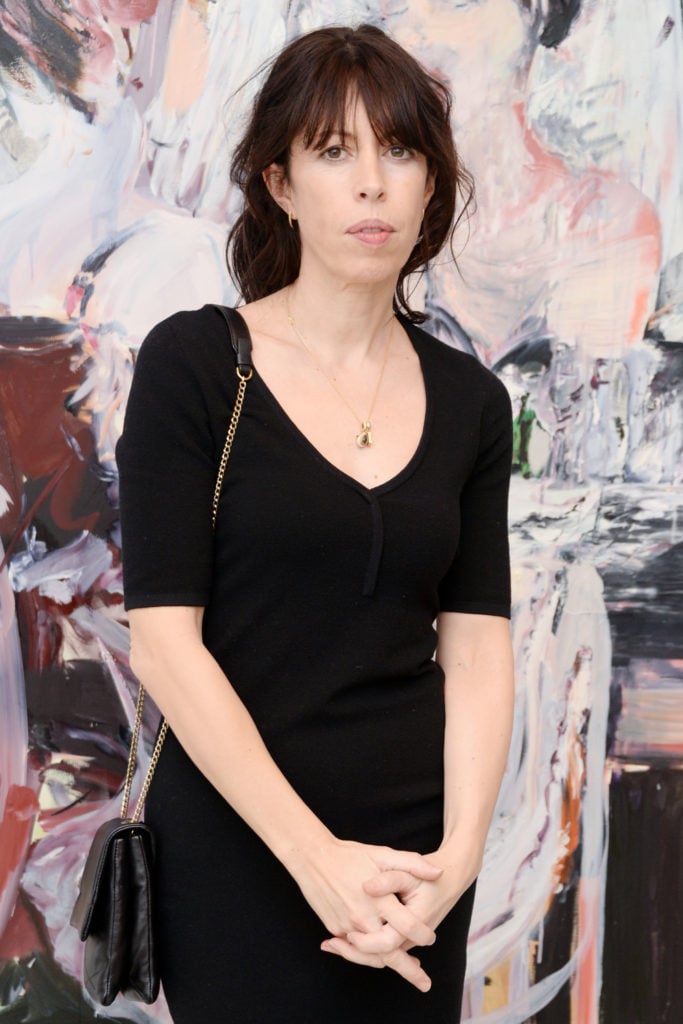
The artist's deep engagement with art history's favorite themes is on view at the Metropolitan Museum of Art from April 4.

Katie White

One could say Cecily Brown is drunk on art history.
Throughout her 25-year career, the virtuosic British artist has engaged with seemingly every aspect of the Western canon—Renaissance artists’ contemplation on our eternal souls, Old Masters’ scenes of revelry, the delightfully frilly and coquettish vignettes of the Rococo era, Impressionists’ voyeuristic eye, even the impassioned gesturalism of Jackson Pollock. She’s guzzled it all.
Now the dizzying scope of these references will come into focus in “Cecily Brown: Death and the Maid,” the first full-breadth museum survey of the artist’s work in New York, which opens at the Metropolitan Museum of Art next week. “I really only understand a painting once I’ve copied it,” Brown said in a video made with the museum. The exhibition promises to unpack these discoveries, bringing together 50 paintings, drawings, sketchbooks, and monotypes—some of which have not been shown in New York before and several which were just recently completed—by delving into recurring themes, both sacred and profane, within her oeuvre. “There’s a whole raft of art history that flows through the work, and a lot of that is represented even in this very careful selection,” said exhibition curator Ian Alteveer in a conversation.
Ahead of the exhibition’s opening we’ve pulled out several works from the show and highlighted how Brown references and reimagines just a few of her many art-historical influences.
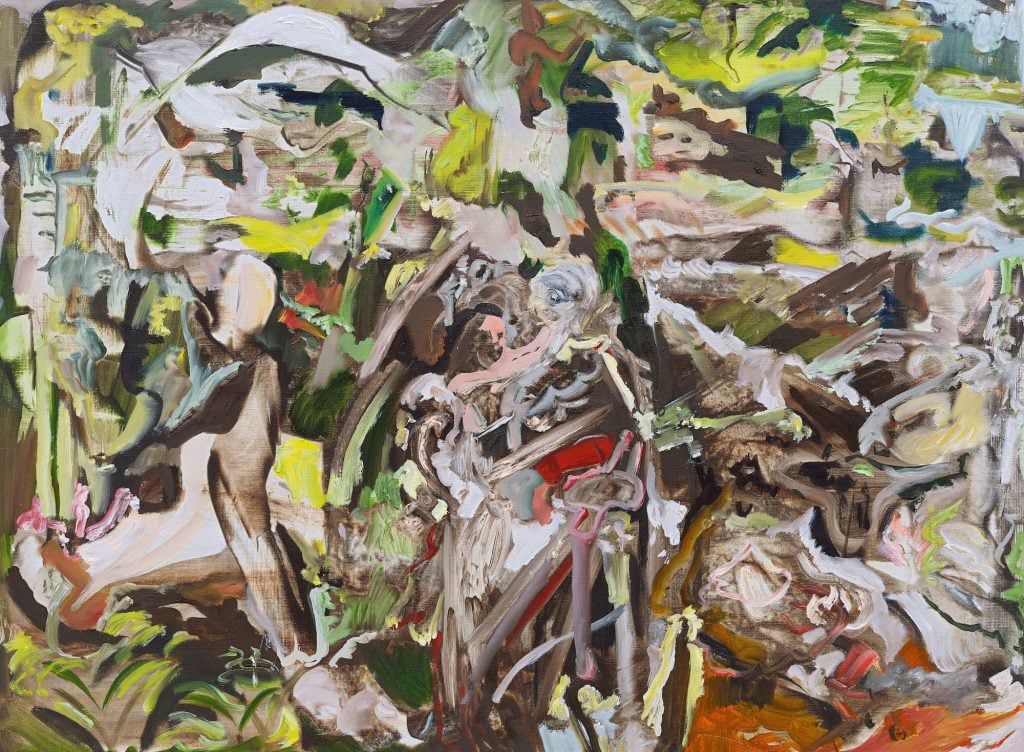
Cecily Brown, Maid in a Landscape (2021). Private collection; © Cecily Brown.
Before seeing even a single work in the exhibition, the title “Death and the Maid” offers us our very first historical window into Brown’s oeuvre. The title is an elision of Franz Schubert’s string quartet, Death and the Maiden (1824), which itself references an earlier Schubert piece, in which a terrified maiden begs death to pass her by. Death replies with bone-chilling comfort, “I am not cruel, you shall sleep gently in my arms.” This terror-laden subject became a popular visual motif during the the Renaissance, particularly in Germany. Such images typically presented a beautiful young woman held, almost tenderly, by the arms of Death, personified as a skeleton. Over the centuries, the subject has been revisited countless times. Two canvases in the exhibition, Death and the Maid (2022) and Maid in a Landscape (2021), as well as a notebook sketch, reflect on this motif.
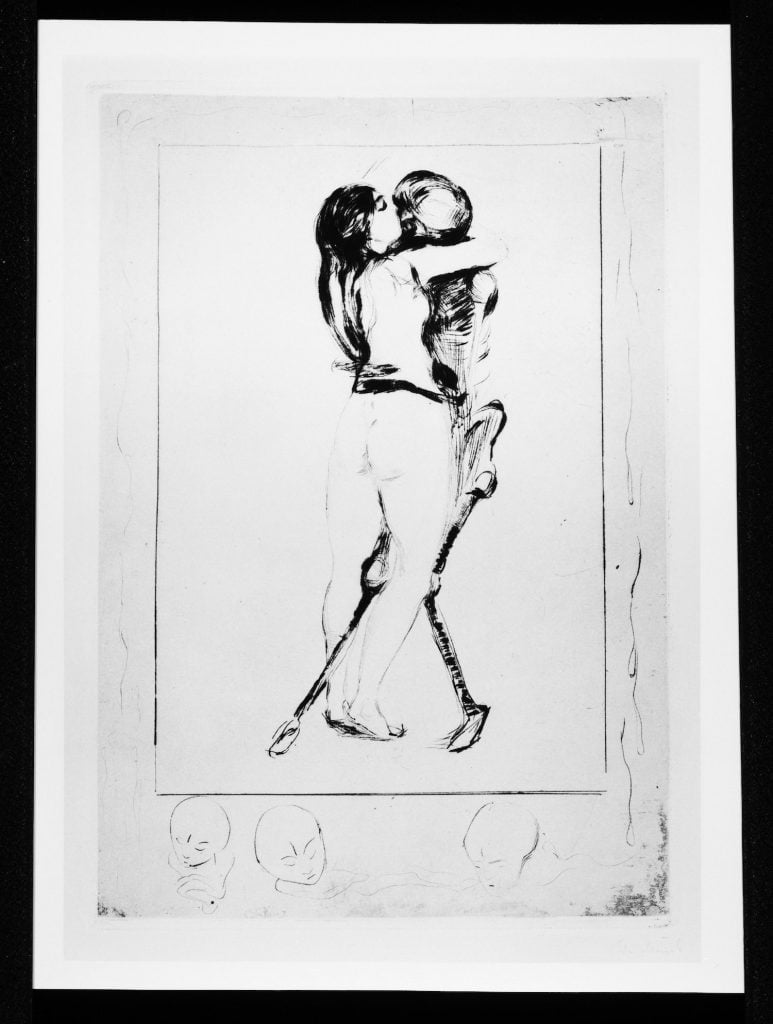
Edvard Munch, Death and the Maiden (1894). Collection of the Philadelphia Museum of Art.
For her depictions, Brown took inspiration from Edvard Munch’s 1894 version of the pair, which seems to show the figures dancing. In preparing for the exhibition, Alteveer had texted an image of the Munch work as a possible source; Brown confirmed by sending a photo of a years-old sketch she’d made of the Norwegian artist’s composition. “Of course Munch was the source for this dancing pair, I thought—the skeletal man’s right leg extends down at the same oblique angle—and the couple frequently returns to haunt Brown’s work,” Alteveer explains in a catalogue essay for the exhibition.
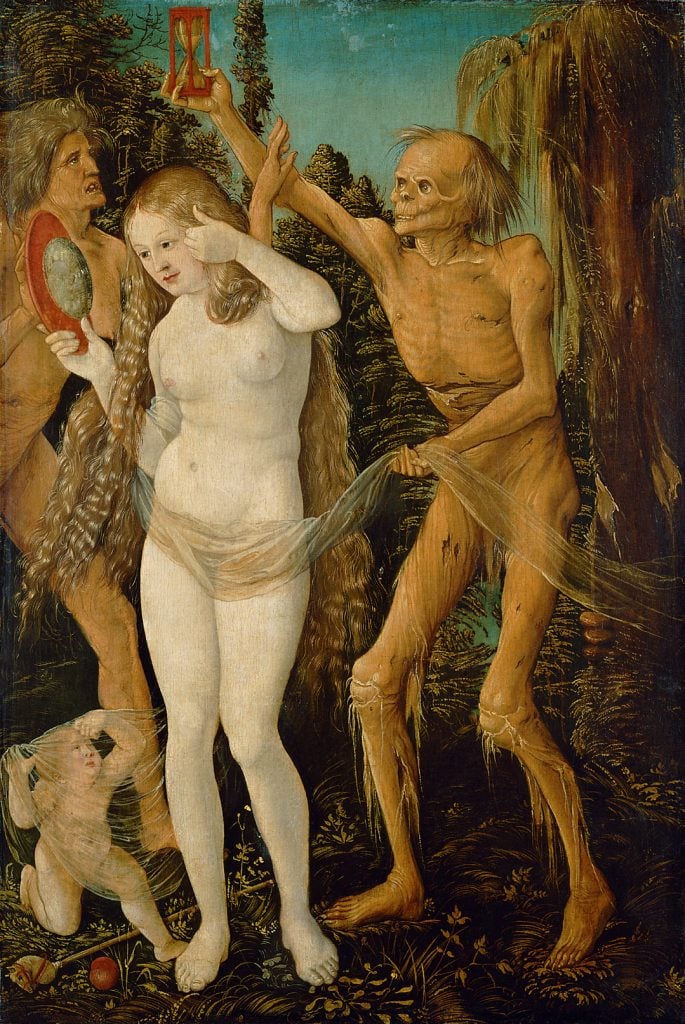
Hans Baldung Grien, The Three Stages of Life and Death. Collection of the Kunsthistorisches Museum Wien, Gemäldegalerie.
At other times, Brown’s references for her depictions of Death as a lover of sorts reach even further back. In Maid in a Landscape (2021), one can glean the influence of Renaissance artist Hans Baldung Grien’s plentiful—and freakish—depictions of Death and the Maiden. Notably, Brown’s interest in the motif does not seem to be one of morose brooding: in titling her own version, Brown cleverly shortened “Maiden” to “Maid,” both as a modernizing of the theme and a nod to her own time spent working as a housekeeper at the beginning of her career—and its a bit of a joke. “Despite this youthful occupation, as she told novelist Rachel Cusk, her own apartments in New York years later were always notoriously messy,” Alteveer notes.
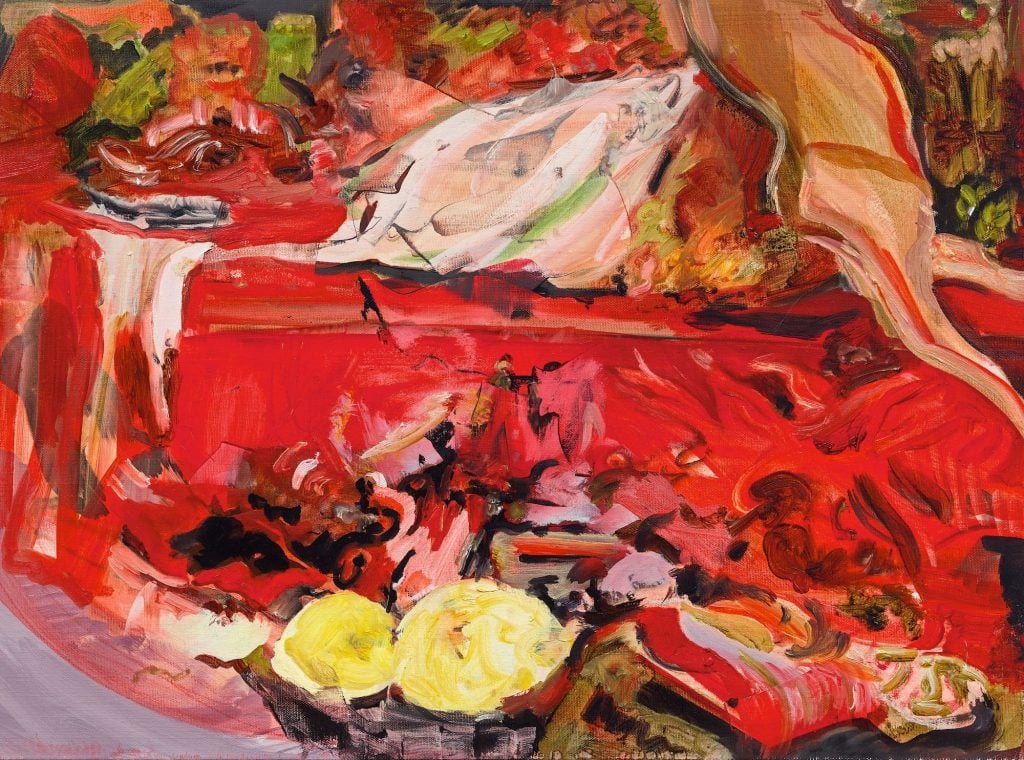
Cecily Brown, Nature Morte (2020). © Cecily Brown.
Once asked to comment on the macabre undertones that permeate her works, Brown remarked, “I always liked the expression ‘The Devil has all the best tunes.’ I always find that I go to a depiction of hell and look at it for an hour and then look at heaven for 30 seconds.” Flemish Renaissance painter Pieter Bruegel the Elder, particularly, has served as a jumping-off point for Brown’s compositions, and Alteveer notes Brown’s affection for his epic scene of reckoning, The Triumph of Death (ca. 1562). The painting is one of deathly pandemonium: a skeletal rider on horseback, wielding a sickle and leading the charge of his throngs of skeleton soldiers, gleefully laying waste to every human in sight. Amid this tumult, a table of revelers, on the lower right of the painting, spring from their seats in terror, leaving their dinner table strewn with food and the games they’d been playing. “In thinking about Bruegel’s painting and its small dinner party interrupted, I’m reminded of so many of Brown’s exuberantly heaped tables—mountains of food, puddles of cloth, chairs tipped over—and the ways in which she layers these reminders of death in near endless and compelling combination,” Alteveer writes.
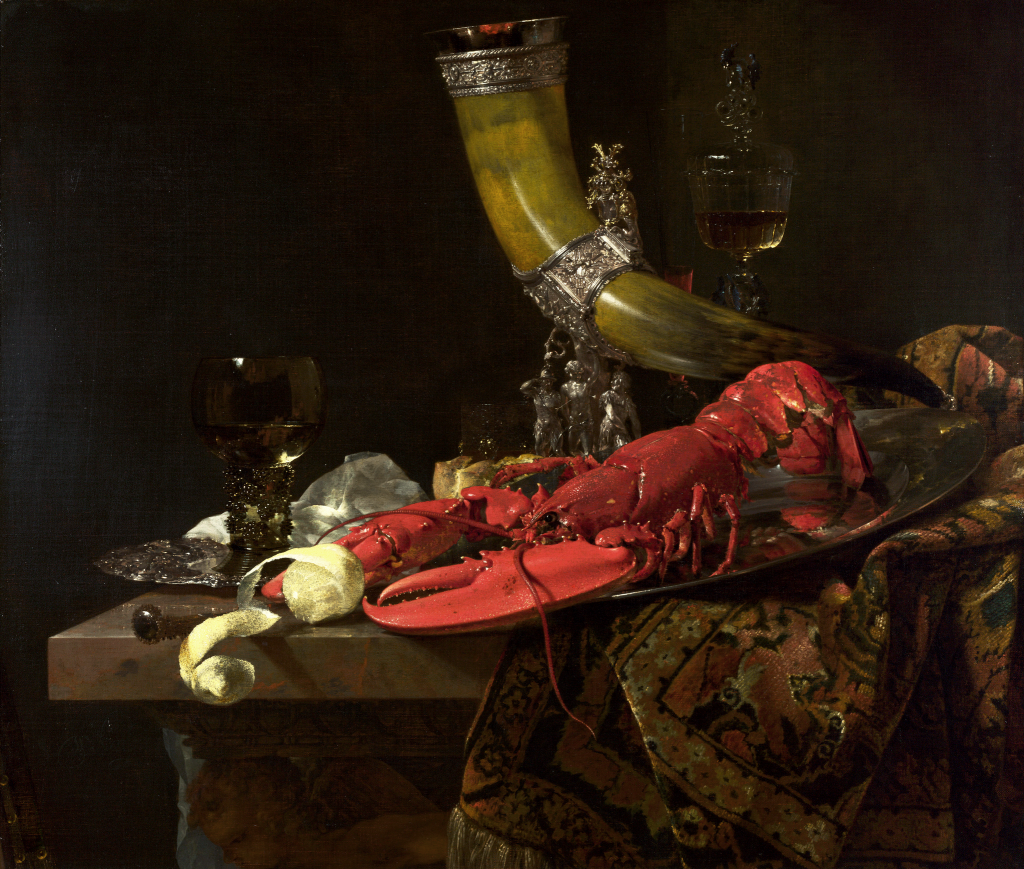
Willem Kalf, Still Life, Still Life with Lobster, Drinking Horn and Glasses (1653). Collection of the National Gallery.
The living body’s proximity to death is one of Brown’s central preoccupations, and decadent tablescapes offer one of the most artistically luxurious ways to approach such themes—as Alteveer described to me, “Still lifes are a way for an artist to show off a little bit, to revel in the plentitude that they offer, and then also to explore color.”
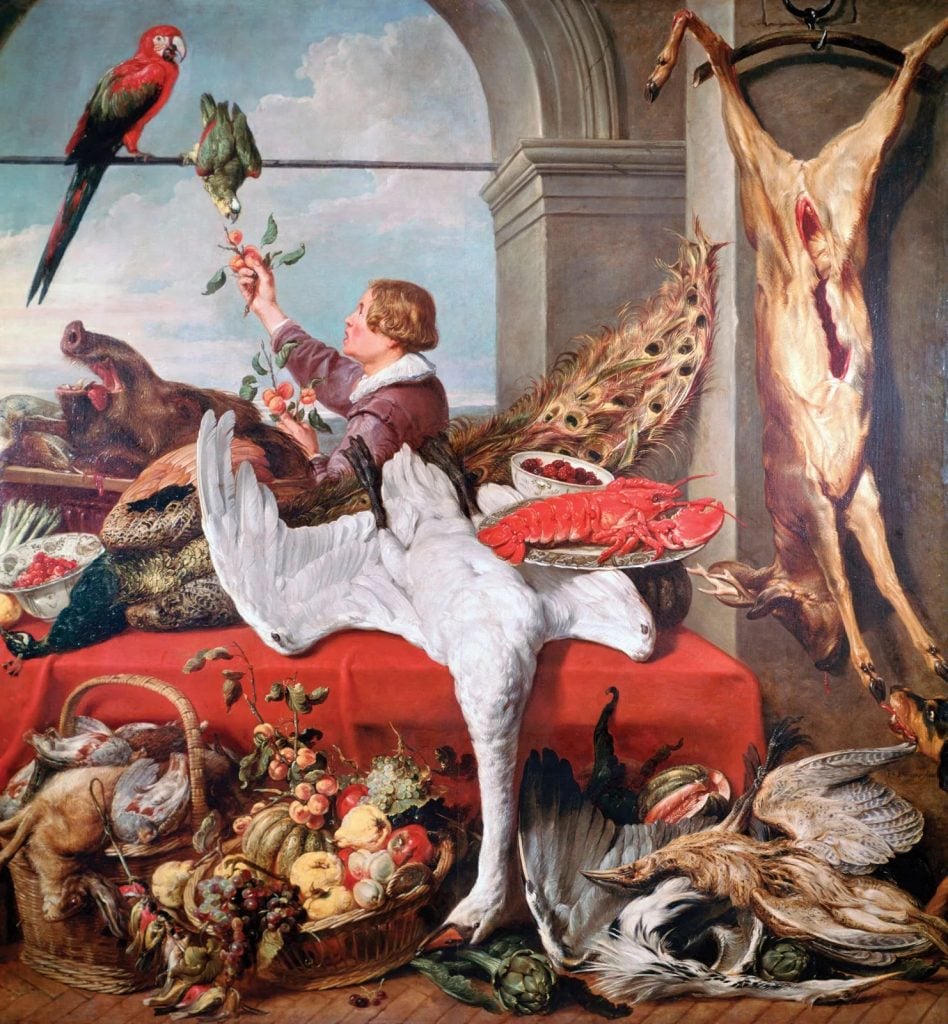
Frans Snyders, Interior of an Office (ca. 1635).
While preparing for an exhibition at Blenheim Palace in the fall of 2020, Brown turned to 17th-century Flemish painter Frans Snyders’s scenes of hunting, a pastime Brown considers decidedly English. From here, she soon found herself enamored with Snyders’s still lifes: disordered tableaux of meat, fruit, wine, and flowers. For Brown—a lifelong vegetarian—the paintings offered not the brutality of the hunt, but a space for lavish and decadent employment of colors. Brown soon commenced her own series of vanitas scenes. Vanitas were popular in Dutch Golden age painting, and operated as symbolic images that hint at the transience of our mortal lives and the ephemerality of earthly pleasures, through depictions of wilting flowers, meats, burning candles, and just-ripe fruits. Her paintings Nature Morte (2020) and Lobsters, Oysters, Cherries and Pearls (2020) call to mind both Snyders’s painting Interior of an Office (ca. 1635) as well as Willem Kalf’s Still Life, Still Life with Lobster, Drinking Horn and Glasses (1653).
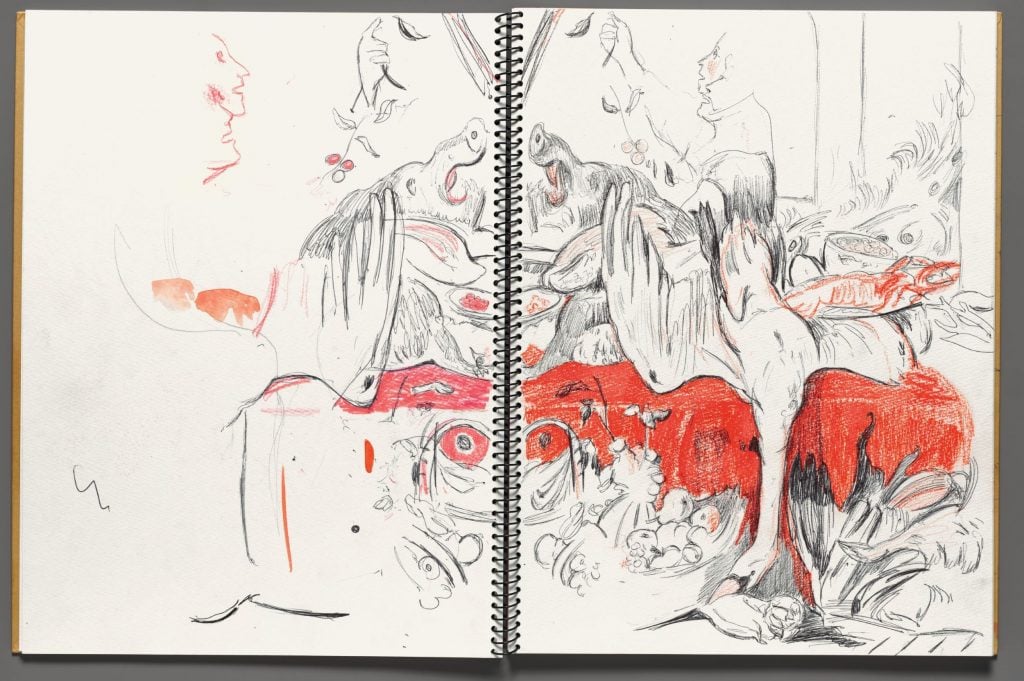
Cecily Brown’s sketchbook (2021–22). Courtesy of the artist.
“Still lifes are kind of an excuse for me to use this dramatic but weirdly neutral setting of a red tablecloth, like in Nature Morte and Lobsters, Oysters, Cherries and Pearls,” she noted in a conversation with Adam Eaker, assistant curator at the Met, that is included in the exhibition catalogue.
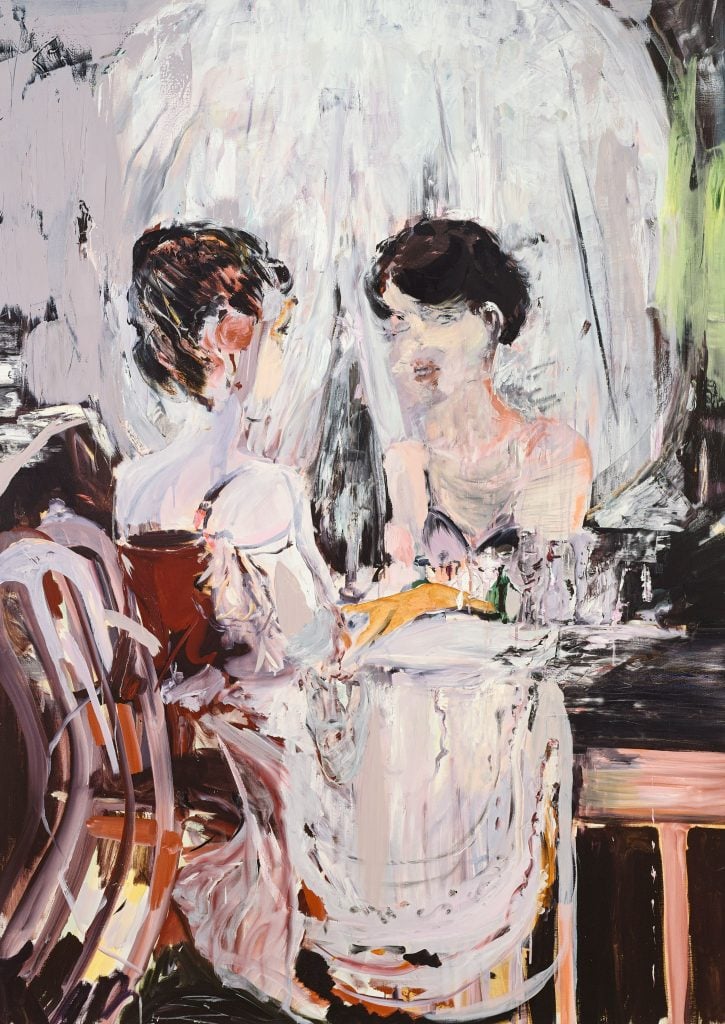
Cecily Brown, Untitled (Vanity) (2005). © Cecily Brown.
Mirrors, with their flat reflective surfaces that swallow up scenes from the world around them, have long held a special place in history of painting: a metaphor for the art of making itself. The mirror, both as as a symbol and as a compositional device, materializes time and again in Brown’s oeuvre, and several depictions of women seated before a vanity or reflected in a mirror appear in this exhibition.
Brown, who grew up in London, often visited the National Gallery, where she often wondered over Diego Velázquez’s The Toilet of Venus (ca. 1647–51).
“Representations of mirrors and mirroring abound in Brown’s paintings, and the artist has revisited many precedents over the years. She has spoken of her fascination with Velázquez’s so-called Rokeby Venus, whose reclining subject faces away from the viewer, and whose reflection seems older and more distant than the curves of her youthful body might suggest,” Alteveer writes. “One can see that fascination in the ways in which Brown’s subjects are reflected differently (or not at all) in mirrors.” Brown’s paintings Untitled (Vanity) (2005) and Vanity (2019–20) hint at her sustained interest in this not self-same woman in the mirror.
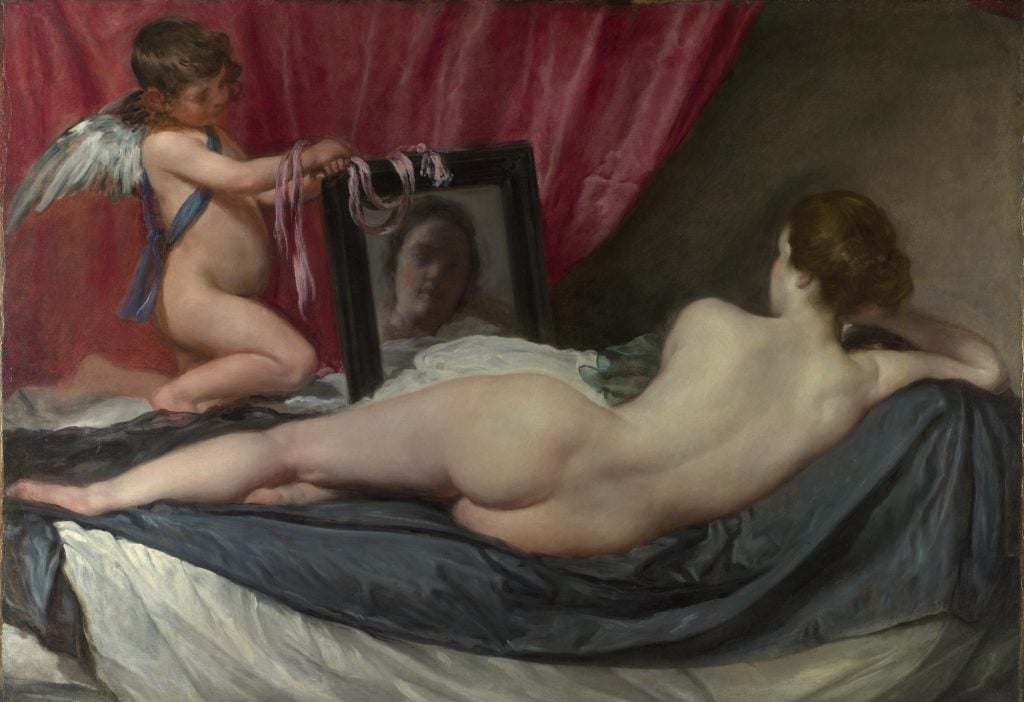
Diego Velázquez, The Toilet of Venus (The Rokeby Venus) (ca. 1647–51). Collection of the National Gallery, London.
But beyond Velázquez, these doubling images also underscore Brown’s enthusiasm for a late Victorian trend for optical allusions. A kind of playful memento mori, these images would winkingly juxtapose images of young women or girls alongside death, usually in the form of a skull. No where is this influence more evident than in Brown’s painting Aujourd’hui Rose (2005), which pictures two young Victorian girls playing with a puppy; their silhouettes, one realizes with a second glance, cleverly form the shape of a skull. In this case, Brown leaves her source imagery largely unobscured—the image is pulled from a popular postcard produced by the Italian card company Alterocca at the turn of the last century.
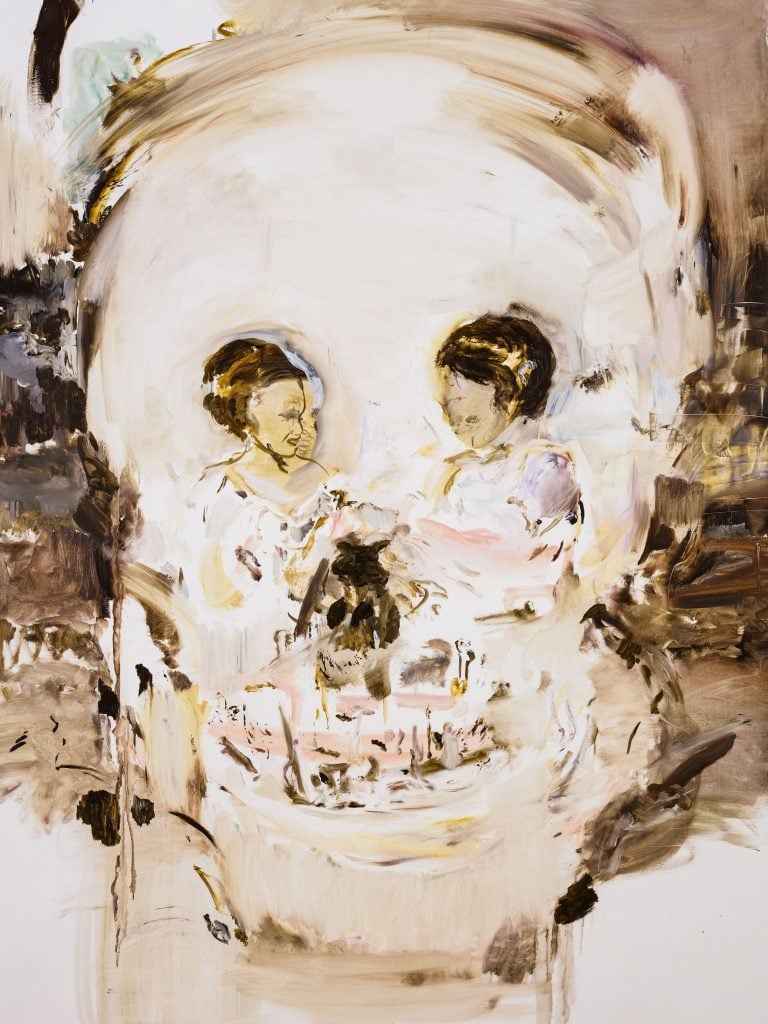
Cecily Brown, Aujourd’hui Rose (2005). © Cecily Brown.
Such visual punning occurs again in All Is Vanity (After Gilbert) (2006): here, we see a woman seated and gazing at herself in the mirror, but when the eye pans out, we see that the mirror and her silhouette form a ghastly skull, and objects and perfumes of her toilette, its strange teeth. This image, too, has a direct reference, in this case All Is Vanity, an illustration by American artist Charles Allan Gilbert published in Life magazine in 1902. In such works, Brown engages the longstanding tradition of the memento mori, a reminder of death’s inevitability through imagery of the skull, while playfully entwining the motif with considerations of feminine beauty, and even cosmetics.
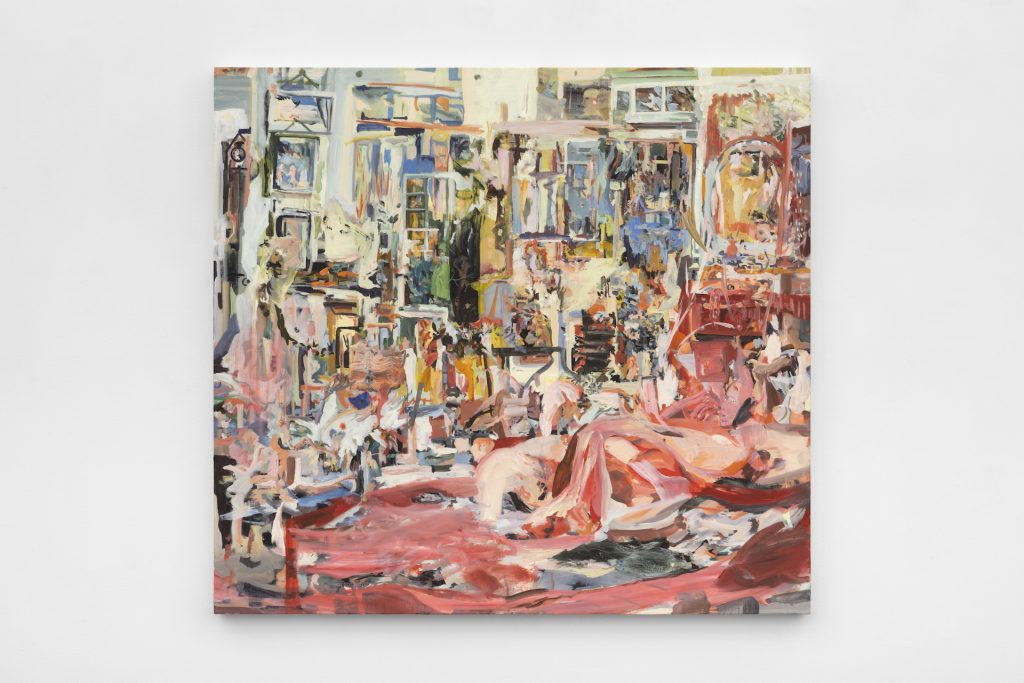
Cecily Brown, Selfie (2020). © Cecily Brown, courtesy of the artist and Paula Cooper Gallery.
Preparation for the Met exhibition largely took place during the tumultuous, home-bound months of 2020 and 2021. Alteveer, for one, believes those periods of isolation left a final impression on the exhibition’s form. In many of the works on view, Brown depicts interior spaces that are crowded, piled high, seemingly bursting with a clutter of objects. In some sense these scenes harken back to fascinations from earlier in career. “A number of earlier works, such as Hangover Square and Untitled (Chambre) (both 2005), center exquisitely cluttered interiors as spaces for discovery,” Alteveer notes.
English artist William Hogarth and his bawdy, instructive scenes of domestic satire, marked by decorative disorder, certainly inform Brown’s often-humorous depictions of the erotic space of the bedroom. The contemporaneous Rococo movement seeps into Brown’s interior worlds as well.
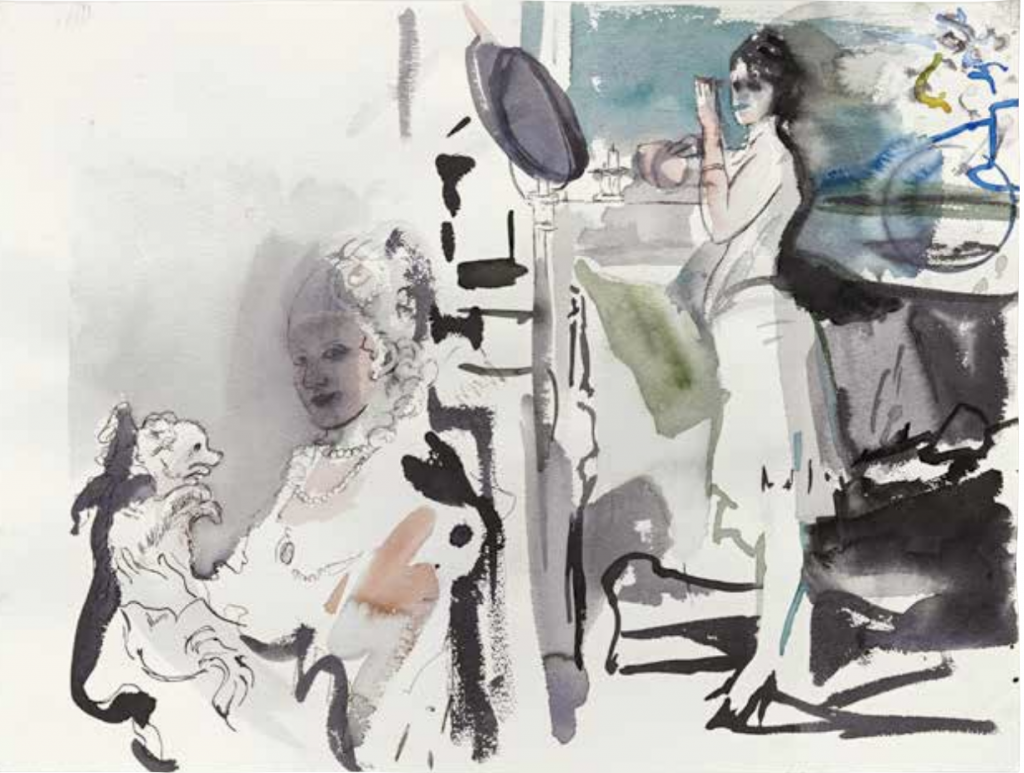
Cecily Brown, Untitled (After Manet and Fragonard) (ca. 2018). © Cecily Brown.
“Indeed, the pinks and yellows of Rococo painting, as well as the plushness of the boudoirs and lushness of private gardens represented by Jean-Honoré Fragonard and François Boucher…have always attracted Brown’s eye, too,” writes Alteveer. Certainly, the ideas of the public and private self are at play here; increasingly so, since Brown often grants her women the freedom to occupy spaces by themselves—a pointed update to her historical references. In one sketch in the exhibition, Brown depicts Fragonard’s Woman with a Dog (ca. 1769) beside a diffuse sketch of Edouard Manet’s Nana, a courtesan, who gazes once again into a mirror. “In Nana, the eponymous courtesan pauses her toilette to gaze directly at the viewer in a critique—and parody—of the Rococo tradition of aristocratic women’s semipublic ablutions; where Nana’s client regards her from a sofa in Manet’s painting, Brown has removed him in her watercolor,” Alteveer explains.
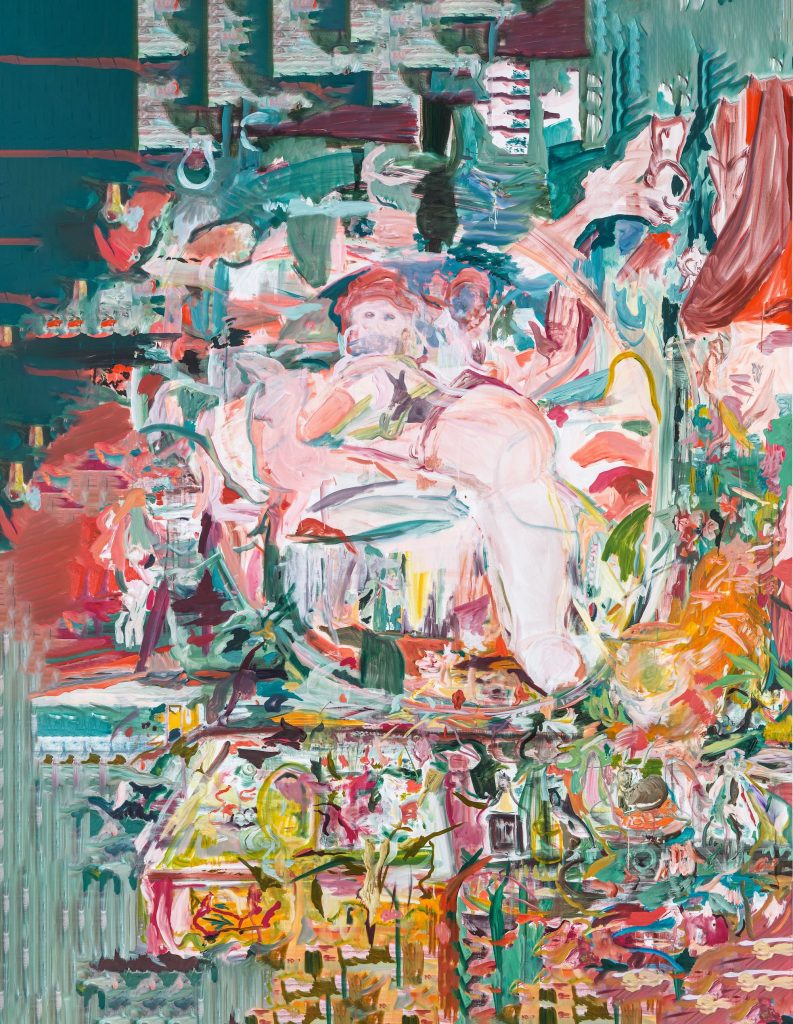
Cecily Brown, No You for Me (2013). © Cecily Brown.
We, the viewer, are forced into the space of the boudoir on occasion. In No You For Me (2013), the mirror of a vanity, round like a moon, now faces the viewer directly. We see a toilette, with perfume bottles, cosmetics are piled seemingly within reach. In the reflection we see not ourselves but a woman’s figure, prone, and nude, lying on a bed. Who is she? Boucher’s Odalisque? Manet’s Nana? We might not know, exactly, but we have crossed the line into intimate space with these art historical muses, nevertheless.
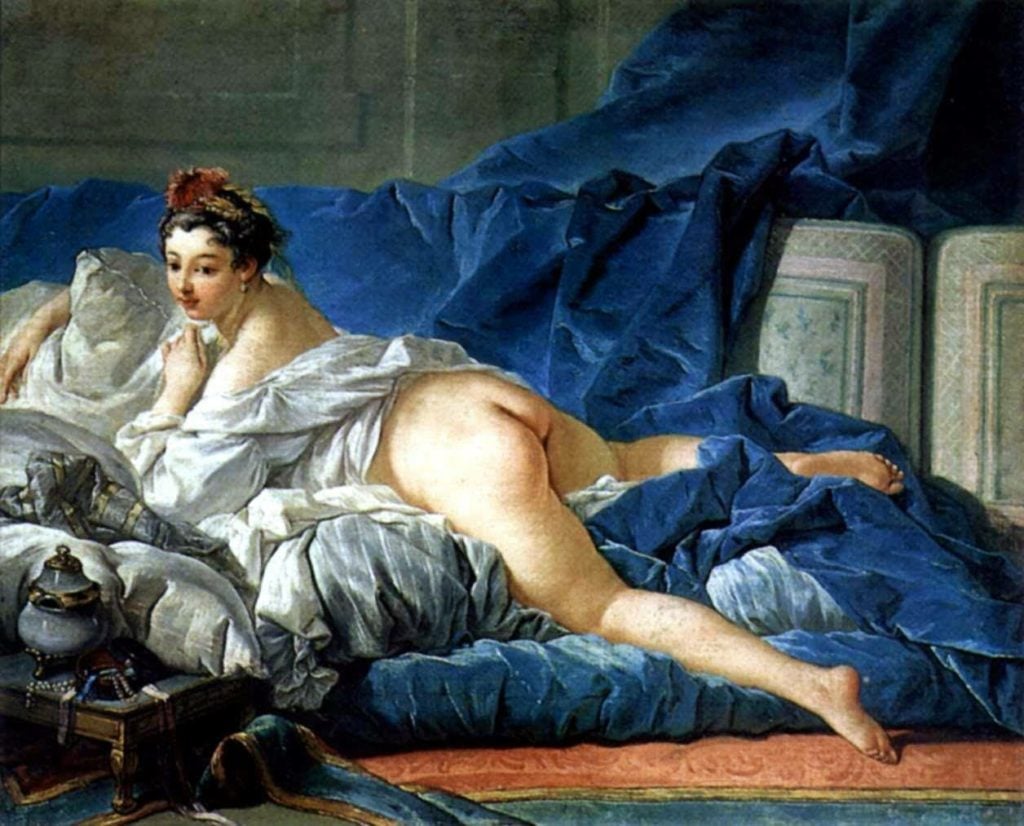
François Boucher, Odalisque (1745). Collection of the Musée du Louvre, Paris.
Selfie (2020) continues this visual puzzle. Here, a nude form (or possibly a couple) lies in repose, surrounded by walls hung with countless paintings. The figure seems to gaze out at the visual plentitude. The scene calls to mind 19th-century paintings of collectors’ personal museums. The “selfie” may ostensibly be Brown herself, quartered away in her studio for months, as painting after painting fills the world around her. “In the recent years, these spaces are overlaid with a kind of new sensibility that evokes the pandemic rooms full of stuff and we’ve accumulated over the years,” Alteveer told me, “And in a way, that drama that happens in Selfie is in part maybe a personal one.”